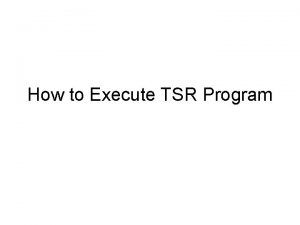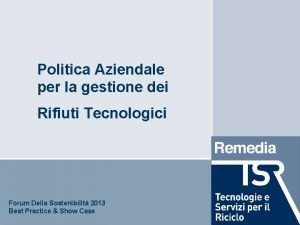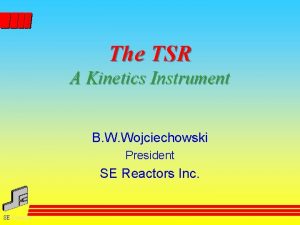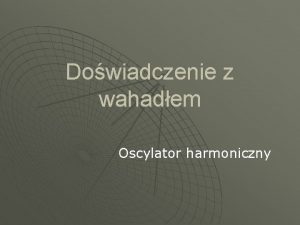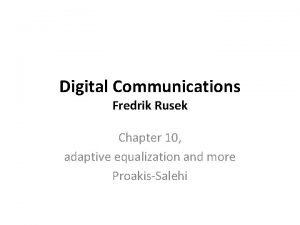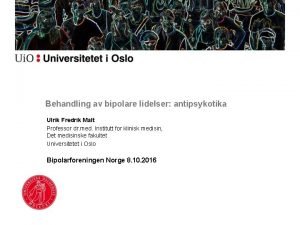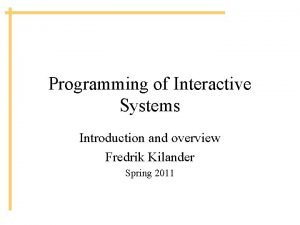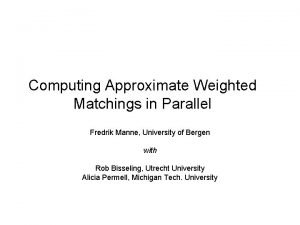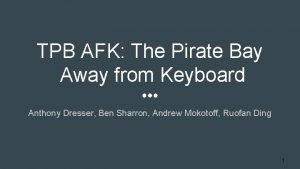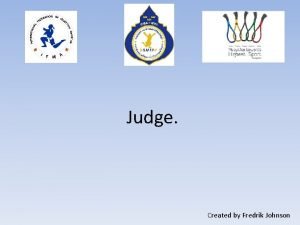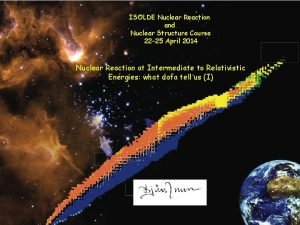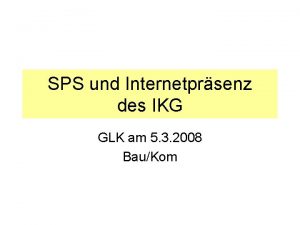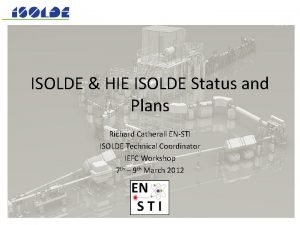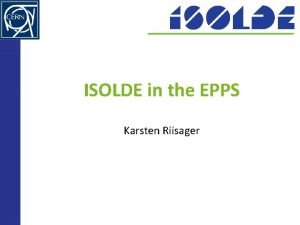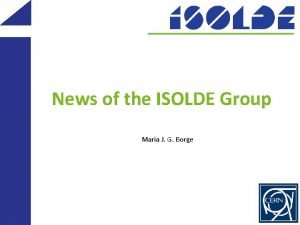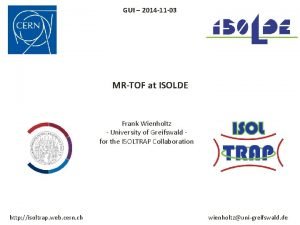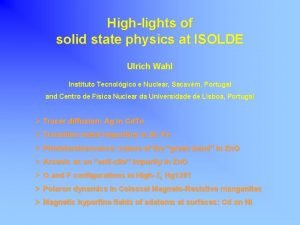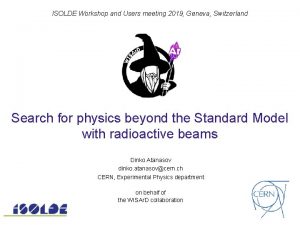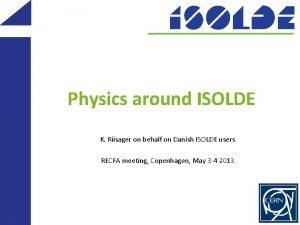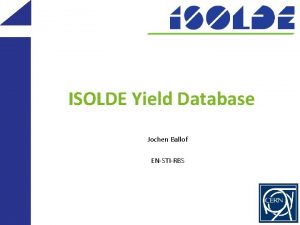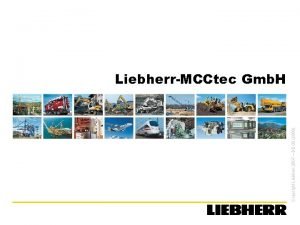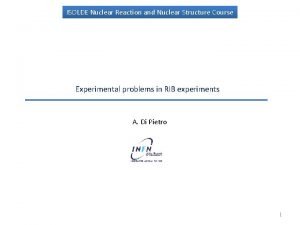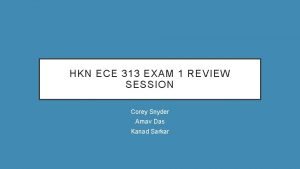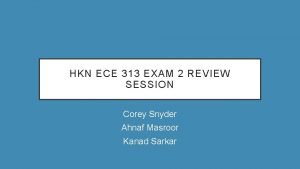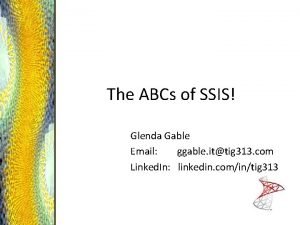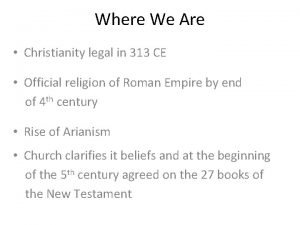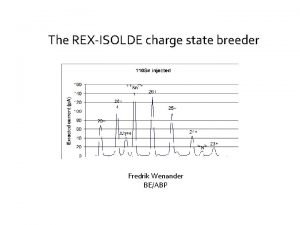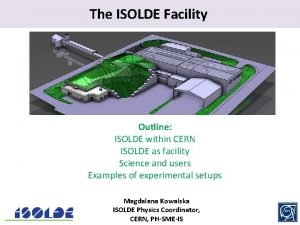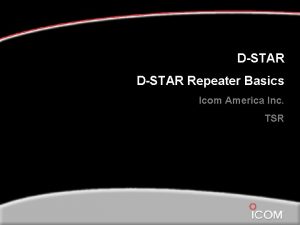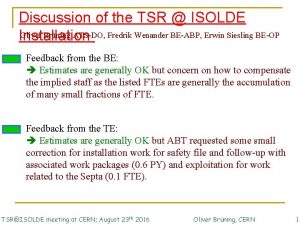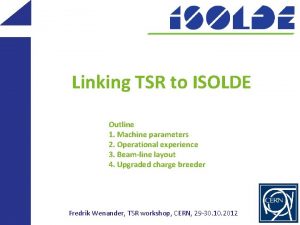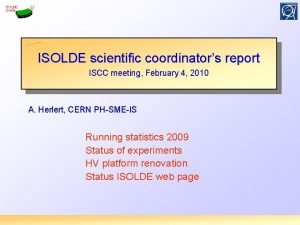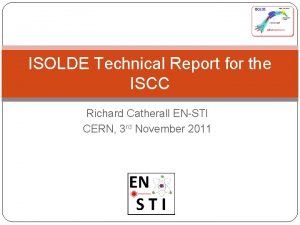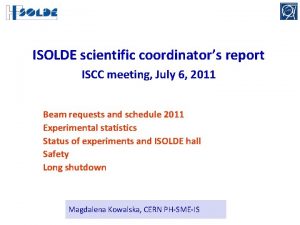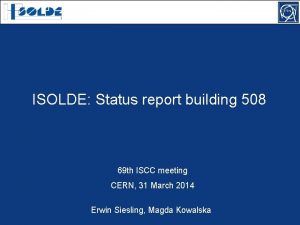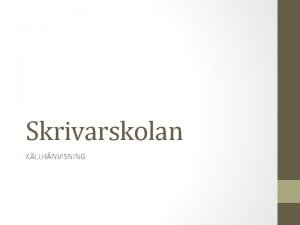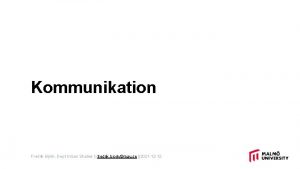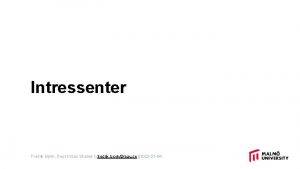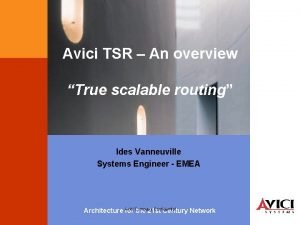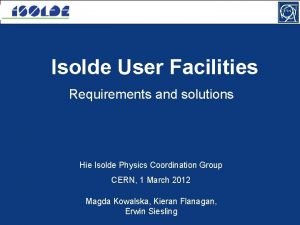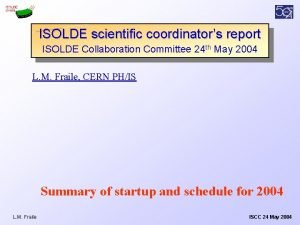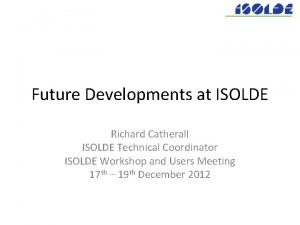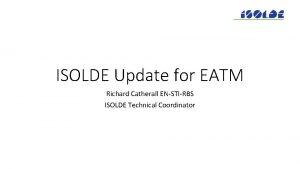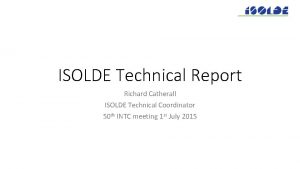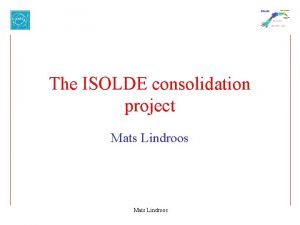ISOLDE TSR Fredrik Wenander ISCC 313 2014 True




































- Slides: 36

ISOLDE TSR + Fredrik Wenander, ISCC 31/3 -2014 = True?

High-energy and low-energy storage rings High-energy Low-energy - ESR @ GSI - CSRe @ IMP - TSR @ ISOLDE - CRYRING @ ESR - RI-RING @ RIKEN - CR @ FAIR - HESR @ FAIR - NESR @ FAIR - RESR @ FAIR - HIAF RI beams originates from opposite side of the energy spectrum Courtesy Y. Litvinov Highly-charged ions at low-energies Easy access to highest charge states Storage Rings for Physics with Exotic Nuclei

Test Storage Rings at Heidelberg experiment resonator ECOOL * In operation since 1988 * Mainly for atomic physics studies and accelerator development * One nuclear physics experiment – FILTEX (internal polarized H 2 gas target) extraction injection Courtesy MPI-K Circumference: 55. 42 m Vacuum: ~few 1 E-11 mbar Acceptance: 120 mm mrad Multiturn injection: m. A current Electron cooler: transverse Tcool in order of 1 s RF acceleration and deceleration possible Typical energy 12 C 6+: 6 Me. V/u www. mpi-hd. mpg. de/blaum/storage-rings/tsr/index. en. html 3

Machine performance 4

Ring beam energy Rigidity (Tm) Storage energy TSR magnetic rigidity range: 0. 25 -1. 57 Tm REX linac 2<A/q<4. 5 Lifetime studies and nuclear structure studies using decay at 5 Me. V/u A/q = 2. 5 W = 14. 5 Me. V/u βγ = 0. 177 Beam can be accelerated (and decelerated) inside the ring HIE stage 2 a A/q =4. 5 W = 9. 3 Me. V/u βγ = 0. 140 Courtesy M. Fraser Takes several seconds though

e-cooling E-cooling needed for: p/p ~ 5 E-5 (rms) p/p < 1 E-5 (rms) for N<1000 1. Reducing momentum spread 2. Stacking of multi-turn injection 3. Compensate for energy loss in target 4. Reducing beam size Light elements easiest to reach low A/q Before cooling After cooling M. Beutelspacher, Diploma thesis, University Heidelberg, 1997 Radial beam extension Tcool – horizontal cooling time for beam with large diameter 6

e-cooling E-cooling needed for: 1. Reducing momentum spread 2. Stacking of multi-turn injection Assembly of 4 movable DSSD positioned up- or downstream of target point 3. Compensate for energy loss in target 4. Reducing beam size Before cooling From T. Davinson and P. Woods After cooling M. Beutelspacher, Diploma thesis, University Heidelberg, 1997 Radial beam extension 7

In-ring experiments 1 * SAS allows for either electron, gas-jet or no target to be installed. * Experimental setups installed on precision rails, moveable in and out from ring. Electron target section * Existing, delivered to CERN * Offers an independent merged cold electron beam dedicated for collision studies 1. See M. Grieser et al. , EPJ Special Topics May 2012, vol 207, Issue 1, pp 1 -117

In-ring experiments 1 * SAS allows for either electron, gas-jet or no target to be installed. * Experimental setups installed on precision rails, moveable in and out from ring. Layout of the new target inlet chamber design with the existing interaction chamber and target dump system for the ESR in Darmstadt. From EXL collaboration * TSR gas-jet study group being formed * Offer to borrow UHV detector setup with DSSDs from P. Egelhof Gas-jet target * Not existing, being studied * Targets with thicknesses of ∼ 1014 atoms/cm 2 for light gases as H 2, d, 3 He and 4 He 1. See M. Grieser et al. , EPJ Special Topics May 2012, vol 207, Issue 1, pp 1 -117

Internal gas target Miniball target thickness 0. 1 to 4 mg/cm 2 -> (3 H-loaded Ti, CD 2, Sn, Pd, Ag etc) NMB_target ~ 1 E 19 atoms/cm 2 To reach the same reaction rate at TSR: Assume: Tlifetime=1 s ddilution 2 m=0. 8 vprojectile=0. 14 c (10 Me. V/u) => NTSR_target=3 E 13 atoms/cm 2 Integrated residual gas thickness much smaller (55. 42 m, 5 E-11 mbar) => 6. 7 E 9 atoms/cm 2 * Target types: H 2 or He Miniball e. g. Cx. Hy * To address: Interaction length ~ 5 mm ideally 1 mm Pressure around target TSR Pure gas Advantage: target purity NB. Can’t use foils in the ring! 10

Beam life times Internal gas target Survival times * Coulomb scattering, electron capture and stripping * Residual gas, electrons in the cooler and gas target M. Grieser et al. , EPJ Special Topics May 2012, vol 207, Issue 1, pp 1 -117 Fully stripped ions -> improved lifetime Effective target thickness: (gas target thickness) x (revolution frequency) x (lifetime) 11 ~100 ug/cm 2 for direct target

Many different ways of operating the machine injection e-cooling ≈0. 5 s measurement ≈1 -2 s Injection rate Reaction measurements CB REXTRAP trapping + cooling injection cooling 0. 2 -1 s e-cool stacking (no target inside the ring) measurement, acceleration, mass separation Based on R. Raabe presentation

Ring injection time • High injection efficiency of outmost importance • Multi-turn injection ε 0. 8 collisions with the septum foil collisions with the acceptance t=length injector pulse Text(10%) ~ 50 us 10% offset TOF after REX charge breeder closed orbit at the septum foil t 25 turns typically 33 ms at 10 Me. V/u Input from M. Grieser 13 Adapt EBIS Textraction to fit beam pulse into transverse acceptance

Beam-line layout 14

Building layout Presently at MPI-K, Heidelberg, a large hall is housing the TSR with enough space around it for experiments and equipment that need to be close to the ring. The basement underneath the ring is used for power supplies and other necessary equipment. 26 m 36 m service tunnel 10 m (7 m between floor and crane hook) Proposed layout to fit the TSR: Installation above the CERN service-tunnel 15 Tilted beam-line coming up from the machine. 4. 73 m above Isolde hall floor 15 E. Siesling Courtesy

Building layout TSR building 670: Taken in account at the construction of the new user building 508. Water station: Water station and cooling tower to be integrated in the ISOLDE area. 670 3 m Service tunnel Roads: Adaptation of the Route Rutherford and corner with Route Einstein. Move of the ramp giving access to the premises to the Route Democrite side. 508 CERN service tunnel: Construction above the tunnel creating two separate basements to house TSR equipment racks and power supplies. 16 Courtesy E. Siesling

Beam-line layout 35 m Position at Heidelberg 4. 15 m e-cooler 12. 73 m 1. Achromatic injection line * Links HIE-ISOLDE to TSR ring via XT 04 * Considers HIE-ISOLDE and TSR floor level difference of 4. 73 m 6. 86 m In-ring experiment 25 m exi s He ting a ide lbe t rg 2. Standard HIE-EBIT elements l ta n t izo ma r ho hro ac M. Grieser XT 04 HIE-ISOLDE HEBT area vertical achromat Beam Injection e-cooler Target RF station system profiler septum HIE-ISOLDE linac 17 Heidelberg layout

Extraction lines 35 m 4. 15 m 6. 86 m 12. 73 m 25 m Injection / Extraction septum t ga g n i st er exi idelb He 18 CERN input: A. Parfenova, D. Voulot, B. Goddard, M. Fraser

Charge breeder upgrade 19

Charge states out of REX Benefits from high q Rigidity TSR Storage lifetimes Cooling times Experiments Charge breeding times for a selection of elements of relevance for TSR@ISOLDE experiments Ion 7 Be 18 F 70 Ni 132 Sn 182 Pb Z 4 9 30 50 82 82 q 3 9 25 39 53 64 A/q 2. 33 2 2. 33 3. 38 3. 43 2. 84 Breeding time (ms) 20 100 350 700 * 1000 * EBIS upgrade needed * to be tested REXEBIS charge breeder capable of producing sufficiently low A/q (or beam rigidity for < 10 Me. V/u) for most elements 20

TSR@ISOLDE implications for charge breeder Experiment Astrophysical p-process capture Species State through* bare Ee~150 ke. V, Je ~1 -2 x 104 A/cm 2 *** H/Li-like Ee~100 ke. V, Je ~1 -2 x 104 A/cm 2 *** Li/Na-like Ee~100 ke. V, Je ~1 -2 x 104 A/cm 2 *** Atomic effects on nuclear half-lives ** DR on exotic ions Atomic data for supernova explosions 1+ to H-like Atomic data for fusion research q>22 Charge breeder requirements Not limiting any charge state Not limiting till H-like * After Z=60 the abundance of bare state will drastically drop ** Only Li-like Tl with acceptable abundance *** Assumed an injection repetition rate of 1 Hz 21 Courtesy A. Shornikov

Pick up reaction at TSR A+1 Y(q+1)+ detector chamber AXq+ AX(q-1)+ AX(q+1)+ quadrupole gas jet: hydrogen target stored ion beam TSR dipole AXq+ separation Reactions Issue nuclear: Þ rigidities of AX(q+1)+ and A+1 Y(q+1)+ are equal p →A+1 Y(q+1)+ + AXq+ → AX(q+1)+ +e ionization: recombination: AXq+ + e → AX(q-1)+ Energy deviation of A+1 Y(q+1)+ and AX(q+1)+ Þ experiment has to be carried out with bare AXq+ ions Dead-time /pile-up due to high flux AX(q+1)+ Slide info from M. Grieser AXq++ 22

Charge states out of REX q But some experiments might require: * Fully stripped to Z~60 * Few-electron system, e. g. for Th/U 100 90 80 70 60 50 40 30 20 10 0 G. Schiwietz and P. L. Grande, Nucl. Instrum. Meth B 175 (2001) 125 REXEBIS 10 Me. V/u stripping Fully stripped 0 50 Z 100 Estimated attainable charge states in REXEBIS and after stripper foil as a function of ion Z Design parameters HIE-ISOLDE / TSR@ISOLDE breeder Upgrade REXEBIS Electron energy [ke. V] 150 5 Electron current [A] 2 -5 0. 2 Electron current density [A/cm 2] 1 -2 x 104 100 Trapping region pressure (mbar) ~10 -11 Ion-ion cooling needed YES NO Extraction time (us) <30 23 >50

No such breeders available 15000 TEST† REX goal LLNL rep† Current density, A/cm 2 HD II est EBIT constellation: high compression, mostly standalone low capacity spectrometry devices MSU rep* Titan est MSU rep* LLNL rep† Shanghai est Tokyo est Titan est CARIBU exp* goal Tokyo est Shanghai est 1500 RHIC HD II est Immersed gun limit TEST† CARIBU exp* EBIS constellation : RHIC REX Low compression, high capaciy injectors 150 1, 0 E+03 Electron beam energy, e. V 1, 0 E+05 1, 0 E+04 rep - reported, est - estimated, * - in commissioning phase † - discontinued Bubble size represents electron current 24 Courtesy A. Shornikov

How we are addressing them High Energy Current and Compression (HEC 2) electron gun project Requirements compared to simulations Influence of B field leaking Matching two focusing systems anode cathode electron beam A. Pikin, E. N. Beebe, and D. Raparia, Rev. Sci. Instr. 84 033303 (2013) Current density in the interaction region Current density in the ionization region, [A/cm 2] Very laminar electron flow, high electrostatic compression 35000 30000 25000 20000 working region 15000 10000 Ie=5 A , B=6 T, Ee=50 ke. V Rc=10 mm, Tc=1500 K 5000 0 0 2 4 6 Field on the cathode, [G] HEC 2 designed at BNL is now a collaborative effort between BNL and CERN 25 8 10

HEC 2 prototype tests at BNL First beam time – 08. 11. 2013 -15. 11. 2013 Anode voltage Extracted current (1 V=1 A) NB: pulsed electron beam Prototype gun design by BNL, built by CERN being tested at BNL by joint team at BNL TEBIS Scenario Ee, ke. V Ie , A Je, k. A/cm 2 HEC 2 ultimate spec 150 5 10 -20 Achieved in 1 -st run 30 1. 54 tba REXEBIS 5 0. 4 0. 2 * These activities supported by HIE-ISOLDE design study will continue in 2014 * Hopefully a continuation within ENSAR 2 26

Technical integration study 27

Technical integration study Two approaches 1. CERN homologation (full-fledged ‘standardization’) 2. Keep-system-as-is (low-budget option with minimal changes) Dismantling and reassembly Control system and applications Inj-ext septum Beam diagnostics 1 General safety Civil engineering and infrastructure Magnets 4 Induction accelerator In-ring experiments 18 work packages Alignment and survey 5 Vacuum 3 Scrapers RF 2 Power converters Radioprotection Extraction line E-cooler Recommendations by CERN specialists 28 1. Obsolete electronics Improve sensitivity 2. Change for Finemet type 3. Exchange bakeout system 4. Improve electrical safety 5. External targets on elements Red: fully replaced Blue: complemented and improved Green: accepted or minor upgrades Orange: not part of costing

Technical integration study - conclusions The radiological concern of importing the ring is minimal. Well advanced civil engineering plan with associated infrastructure exists. No technical show stoppers for the implementation – standard solutions identified. Keep-system-as-is CERN integration proposal a. First cost and manpower estimate believed to be conservative. However, no contingency included. b. Most CERN groups have insisted on hardware changes and CERN standardization and discourage a 3 years transition period. Total cost and manpower for transfer and integration into a CERN facility: 15. 2 MCHF 27. 5 FTE (man year) NB. The figures have not been considered the CERN management a. Would need to keep all subsystems as they are since many are interlinked with the control system. b. Would have limited / no support by CERN groups; longer dependence on MPIK Heidelberg. The approximate cost and manpower need for the Keep-system-as-is scenario are: 11. 8 MCHF 17. 1 FTE (man year) The cost saving might appear low. Reasons: * The main cost drivers are the injection line, buildings and infrastructure. * Some spares, complementing parts and replacement parts are absolutely necessary. * Includes the mandatory electrical protection of magnets connections. * Includes sensitivity improvement of the beam diagnostics. 29

Tentative implementation schedule n a m m e ag e v ro p p ta No N R E C y b d t n e excerpt from 20140328 30

Past, present and future …. . * Lo. I to the ISOLDE and Neutron Time-of-Flight Committee http: //cdsweb. cern. ch/record/1319286/files/INTC-I-133. pdf * TSR at ISOLDE technical design report M. Grieser et al. , EPJ Special Topics May 2012, vol 207, Issue 1, pp 1 -117 * Approved by CERN Research board, May 2012 “The installation of TSR, as an experiment to be included in the HIE-ISOLDE programme, was approved by the Research Board. The timescale will be defined once the study of its Integration has been completed. ” * Presentation of the integration study to the CERN Research Board Nov 2013 * TSR@ISOLDE workshop at CERN 14/2 -2014 – focus on experiments * Tentative planning for the installation of TSR@ISOLDE handed over to the BE department leader 28/3 -2014

Plain sailing? Operational complexity challenges ISOL + REX low energy stage + RT + SC LINAC + ring injection + e-cooling + storage 2 s holding time (or longer) in REXTRAP < 30 us extraction from REXEBIS + efficient injection cooling time -> sets lifetime limit life-time issues * All for very low beam intensities compared to Heidelberg – not even visible? * All steps involves unavoidable losses NB! Different from: rings at in-flight facilities rings with stable beam Optional (complexity) Gas-jet target Slow extraction to external setups: * even longer holding time in REXTRAP required * will the good longitudinal energy spread be conserved due to RF excitation? * efficiency <85% 32

1. 7 Li contamination from ISOLDE 14 N 6+ contamination from REXEBIS 2 c Laser spectroscopy of rare isotopes with the TSR Capture reactions for the astrophysical p-process 4 a 4 b 4 c Nuclear structure through inelastic scattering and transfer reactions 5 a 5 b 5 c 5 d 5 e External spectrometer Long-lived isomeric states Beam emittance 2 b Gas-jet size 2 a Detectors Half-lives of 7 Be in different atomic charge states Storage life-time Efficiency In-flight beta-decay of light exotic nuclei Beam purity E-cooling time Type of experiment Charge breeder upgrade Experimental challenges 1 6 a 6 b Di-electronic recombination on exotic ions 4 a. life-time needs to be longer than cooling time 4 b. electron pick-up in gas-jet limits the storage lifetime 4 c. fully stripped ions required 6 a. losses during injection/extraction 6 a. if CW requested, long holding time in REXTRAP required 6 b. increased long. momentum during extraction? 7. very high charge state required for Schottky detection 7 Atomic effects on nuclear halflives 3. e-cooling time set lower life-time limit 5 a. e-cooling time set lower life-time limit 5 b. electron pick-up in gas-jet limits the storage lifetime 5 c. Higher charge states improve storage life-time 5 d. UHV detectors moved out from beam during beam injection 5 e. difficulty to arrange well-defined target vertex 3 optional 2 a. life times: 6 He 0. 8 s (no e-cool stacking) 8 He 119 ms (no e-cool stacking) Be 13. 8 s (e-cool stacking) 2 b. REX efficiency for 6 He is sub-percent. In addition impossible to store in REXTRAP for long bunching. 8 He same problems. 2 c. if no e-cooling, force to resolve ke. V superimposed on Me. V 8. very high charge state required for Schottky detection experimental request for H- or Li-like ions 8 9 33 9. experimental request for Li- or Na-like ions

Lifetime determination of 7 Be 3+ Accumulate 109 ions: 108 ions injected with multi turn injection and 10 ECOOL stacking cycles filling time 30 s 109 injected 7 Be 3+ ions number of 7 Be 3+ and 7 Li 3+ which has to be measured 7 Li 3+ decay lifetime ions NLi=17400 7 Be 3+ ions Slide from M. Grieser remark: 109 7 Be 3+ ions is below the space-charge limit: N=5. 8 109 this means the life-times t. Be and t. Li should not effected by the beam intensity ! 34

General conclusions * The technical aspects of the integration have been studied. No technical showstoppers identified. * Cost and manpower analysis of the integration has been performed. * Request feedback from the user community about the layout of the extraction lines and experimental setups. * Tests of charge breeder upgrade on-going. Concept promising but a long way to go. * Operational and experimental difficulties shouldn’t be underestimated or ignored at this stage. 35

Personal plead To continue the HEC 2 studies (REXEBIS upgrade) I need: • work affiliation for A. Shornikov from start of ENSAR 2 (1/3 -2015 ? ) for 30 months • bridging of his contract between fellowship (terminates 31/12 -2014) and start of ENSAR 2 (1/3 -2015? ) Firm confirmation needed by mid April for me to pursue ENSAR 2 proposal 36
 Quiz 4-1 congruent triangles
Quiz 4-1 congruent triangles Tsr in c
Tsr in c Nrg-gy018
Nrg-gy018 Remedia tsr
Remedia tsr Tsr surveyors
Tsr surveyors Okres drgań
Okres drgań Fredrik smulter
Fredrik smulter Optimal receiver
Optimal receiver Madrs skår
Madrs skår Mr fredrik
Mr fredrik Fredrik linde smhi
Fredrik linde smhi Fredrik hansson lege
Fredrik hansson lege Orfiril vektøkning
Orfiril vektøkning Fredrik manne
Fredrik manne Fredrik hansson lege
Fredrik hansson lege Pirate bay away from keyboard
Pirate bay away from keyboard Fredrik johnson
Fredrik johnson Isolde martinson
Isolde martinson Ikg rt
Ikg rt Isolde
Isolde Karsten riisager
Karsten riisager Isolde maria johan
Isolde maria johan Isolde frank
Isolde frank Isolde reveal
Isolde reveal Isolde workshop
Isolde workshop Isolde k
Isolde k Isolde yield database
Isolde yield database Isolde liebherr
Isolde liebherr Reaction structure
Reaction structure True or false true or false
True or false true or false Chapter 2 jesus christ true god and true man
Chapter 2 jesus christ true god and true man Ucc 2 609
Ucc 2 609 Ece 329 uiuc
Ece 329 uiuc Uiuc ece 329
Uiuc ece 329 Ssis-313
Ssis-313 313 ce
313 ce The edict of milan
The edict of milan

